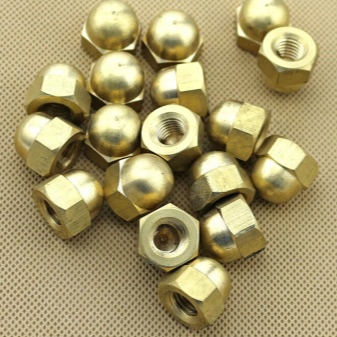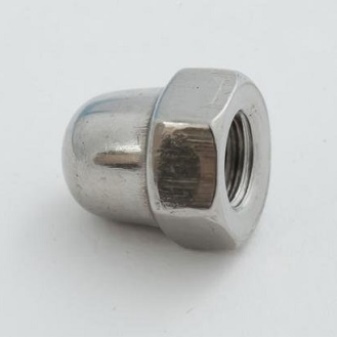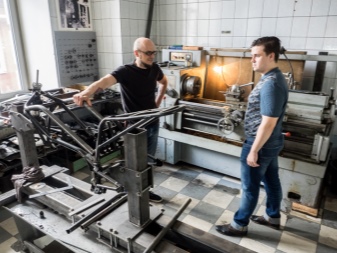All about cap nuts

Cap nuts are used wherever a beautiful and reliable threaded connection is required. Such decorative nuts are designed for threads M8 and M3, M6 and M10, M12 and M4, and their geometric dimensions and strength properties correspond to GOST 11860-85 or DIN 1587.


Peculiarities
The cap nut is a combination of a regular hex nut and a ball cap. Compared to standard fasteners, it has a number of advantages.
- Esthetic appearance of the connection. The decorative nut looks much better than the protruding thread of the bolt and is less eye-catching. In addition, it can be painted with paint, and unlike a regular nut, it can be easily unscrewed.
- Security and corrosion resistance. Moisture and corrosive substances do not get on the thread, therefore the connection rusts less.
- Security. The spherical cap completely hides burrs, threads and protruding bolts, so it is impossible to get scratched or injured on them.
- Ease of dismantling. Dust and dirt do not accumulate on the threads, so the decorative fasteners are easier to unscrew.
There is only one drawback - you need to correctly select the protruding length of the bolt. Well, such hardware is a little more expensive. Typically, cap nuts work without heavy loads and therefore do not require a washer. But if the connection must be strong, then you must first put a washer, then tighten the usual nut and then screw on the cap nut, which will act as a lock nut. Then all the advantages are retained and a strong connection is obtained.

Types and sizes
The widespread use of cap hardware is due to the abundance of their types and sizes. GOST 11860-85 provides for 2 designs of cap nuts - spherical (version 1) and flatter (version 2). They differ in the depth of the cap. Version 2 requires a more precise adjustment of the bolt length. If this is neglected, then not all threads will be involved and the connection will lose strength or the top of the bolt will rest against the cap and the nut will be impossible to tighten. Therefore, execution 1 is more common.
Some companies make custom-made cap nuts from a drawing or sketch. Their shape, size, material and finish may differ from the generally accepted ones. They will fully meet the requirements of the customer. Some types are equipped with a collar for washer or sealing washer. Some nuts have additional nylon rings. Thanks to this, the connection withstands vibration better, and the likelihood of arbitrary loosening is minimal.
In addition, the thread gets additional protection from dust and dirt.


All the abundance of options is standardized by GOST 11860-85 (for domestic products) and DIN 1587 (for foreign products). So, the nominal thread diameter should be:
- M3;
- M4;
- M6;
- M8;
- M10;
- M12;
- М14 (not recommended for use);
- M16;
- М18 (not recommended for use);
- M20;
- М22 (not recommended for use);
- M24.


The thread pitch is large and small.
- Big step used by default and is not indicated in the labeling. It ranges from 0.5 to 3 mm and depends on the nominal thread diameter. Such fasteners perform better under heavy loads, have higher thread accuracy and lower cost.
- Small step can only be found in nuts M8, M10, M14 and M24. It tolerates small vibration and alternating loads better, therefore such nuts are used in high-precision mechanisms in mechanical engineering and other fields of technology.
The rest of the nuts do not have a fine pitch.For example, M6 nuts (often used in food processing equipment and furniture manufacturing) and M12 nuts (used in the construction industry) do not have a fine thread pitch.

GOST 11860-85 also specifies other requirements.
- The diameter of the circumscribed circle is from 6 to 40 mm. This must be taken into account if the nut is placed in a socket for a socket wrench or for calculating the location of the bolt when the connection is at the very edge of the parts.
- The size of the nut on a turnkey basis is from 5.5 to 36 mm. When choosing a hardware, you can immediately determine the size of the tool with which this nut will be tightened, and select it in advance.
- The smallest turnkey height is from 2.75 to 15 mm. This is necessary to calculate the clamping force or the dimensions of the connection so that the hardware does not go beyond the dimensions of the parts.
- Weight of 1000 pieces of nuts - from 0.92 kg (with a section of 3 mm) to 192.6 kg (with a section of 24 mm). The weight of the fasteners must also be taken into account, especially if the connection is made on the moving parts of the precision mechanism or the support is not reliable.


Also, this GOST provides links to other documents that determine the design features of cap nuts and its properties. So, GOST:
- 10549 - thread undercut;
- 24705 - geometric dimensions of the thread and tolerances for its deviations;
- 1759.3 - surface defects of hardware and methods of their control;
- 1759.1 - maximum deviations of the shape of nuts and dimensional accuracy;
- 1759.0 - technical requirements for already manufactured hardware, their mechanical properties and appearance.

DIN 1587 defines the dimensions and material for the production of blind nuts. This could be:
- carbon, alloy steels;
- structural and stainless steels;
- galvanized or other coated steels (chrome-plated, galvanized);
- non-ferrous metals, brass, bronze, aluminum;
- hard plastics.
Thread diameter - from M4 to M24. A protective layer based on zinc or nickel can be applied to the surface.


Dimensions must be within:
- outer section of the cap - from 6.5 to 34 mm;
- the height of the hexagon is from 3.2 to 19 mm;
- total nut height - from 8 to 42 mm;
- the width of the "turnkey" hexagon is from 7 to 36 mm.
The standards do not apply to the shape of the cap bottom.

Applications
Cap nuts are used to add aesthetics to the equipment and hide its external imperfections. The scope of their application is constantly expanding. This could be:
- furniture manufacture;
- mechanical engineering;
- instrumentation;
- manufacturing of various equipment, including medical;
- food industry;
- bicycles and motorcycles;
- design objects.


The main nuances of use are as follows:
- hardware with a small pitch and a nylon ring work well with vibration, the probability of spontaneous unwinding is extremely low;
- fasteners with a large nominal diameter and coarse pitch are used for high axial loads when the thread is breaking off.
Cap nuts must be handled in the same way as conventional nuts. Before mounting on the threads, it is advisable to apply lubricant, the tightening force should correspond to the size of the fastener, and the connection sometimes needs to be checked and tightened.
In the following video, you will find a brief overview of DIN 1587 cap nut.













The comment was sent successfully.